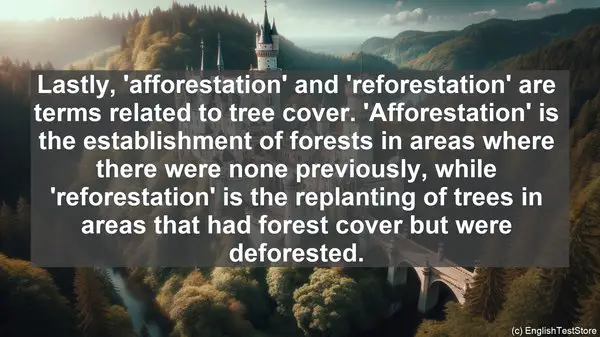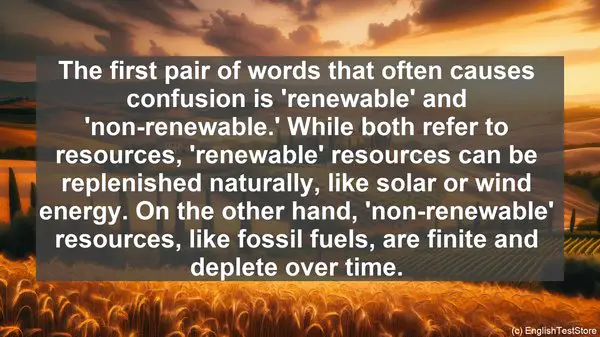Introduction
Welcome to today’s lesson on renewable resource management. In this lesson, we’ll be discussing the top 10 commonly confused words in this field. Understanding these words is crucial for effective resource management. So, let’s dive in!
1. Renewable vs. Non-Renewable
The first pair of words that often causes confusion is ‘renewable’ and ‘non-renewable.’ While both refer to resources, ‘renewable’ resources can be replenished naturally, like solar or wind energy. On the other hand, ‘non-renewable’ resources, like fossil fuels, are finite and deplete over time.

2. Conservation vs. Preservation
Next, we have ‘conservation’ and ‘preservation.’ Though similar, they have distinct meanings. ‘Conservation’ focuses on sustainable use, ensuring resources are available for future generations. ‘Preservation,’ however, emphasizes protecting resources in their pristine state, often with minimal human intervention.
3. Biodiversity vs. Species Richness
Moving on, ‘biodiversity’ and ‘species richness’ are often used interchangeably, but they differ. ‘Biodiversity’ encompasses the variety of life at various scales, including genetic and ecosystem diversity. ‘Species richness,’ on the other hand, specifically refers to the number of different species in a given area.
4. Mitigation vs. Adaptation
In the context of climate change, ‘mitigation’ and ‘adaptation’ are crucial terms. ‘Mitigation’ refers to actions that reduce greenhouse gas emissions, addressing the root cause. ‘Adaptation,’ on the other hand, involves adjusting to the existing or anticipated impacts of climate change.
5. Carbon Footprint vs. Ecological Footprint
Both ‘carbon footprint’ and ‘ecological footprint’ relate to environmental impact, but they differ in scope. ‘Carbon footprint’ specifically measures the greenhouse gas emissions associated with an individual, organization, or activity. ‘Ecological footprint’ is broader, considering the overall resource consumption and waste production.
6. Renewable Energy vs. Clean Energy
While ‘renewable energy’ refers to sources like solar, wind, or hydro, ‘clean energy’ is a broader term. ‘Clean energy’ not only includes renewables but also encompasses low-carbon or non-polluting sources, like nuclear power or even energy efficiency measures.
7. Sustainable Development vs. Sustainability
Often used interchangeably, ‘sustainable development’ and ‘sustainability’ have subtle differences. ‘Sustainable development’ refers to the balance between economic growth, social progress, and environmental protection. ‘Sustainability’ is a broader concept, encompassing the long-term viability of systems, including ecological and social aspects.
8. Erosion vs. Weathering
In geology, ‘erosion’ and ‘weathering’ are distinct processes. ‘Weathering’ refers to the breakdown of rocks or minerals in situ, while ‘erosion’ involves the transport and deposition of the weathered material by agents like wind, water, or ice.
9. Biomass vs. Biofuel
While ‘biomass’ refers to any organic matter, ‘biofuel’ specifically denotes the energy-dense fuels derived from biomass, like ethanol or biodiesel. Biomass can have various uses beyond fuel, such as in the production of bioplastics or as feedstock in industrial processes.

10. Afforestation vs. Reforestation
Lastly, ‘afforestation’ and ‘reforestation’ are terms related to tree cover. ‘Afforestation’ is the establishment of forests in areas where there were none previously, while ‘reforestation’ is the replanting of trees in areas that had forest cover but were deforested.
